
A city looks different when the streets are liquid. Step off the pavement and onto the water, and everything shifts.
Across Europe, the most revealing vantage point isn’t from a tower or tram: it’s from the waterline.
Want the kind of travel that slows you down just enough to see what others miss?
If you’re ready to see Europe through its most poetic, unpredictable, and unforgettable routes, start where the current takes you.
The Seine: A Living Museum Through the Heart of Paris
Floating down the Seine is like flipping through the pages of a living museum. On one bank, you glide past Notre-Dame and the Latin Quarter, and on the other, the Louvre and Eiffel Tower rise into view. River cruises along the Seine offer far more than sightseeing; they create a calm, floating connection to a city otherwise bustling with movement.
Local Parisians often gather along its banks with wine and cheese in tow, especially during golden hour. It’s no coincidence that artists like Monet and writers like Hemingway found inspiration in the light that dances off the Seine’s surface. For visitors, experiencing the city from this angle reshapes the narrative of Paris into something deeply personal and unforgettable.
Amsterdam: Where the Streets Are Made of Water
While Paris may romance you, Amsterdam charms you with its gentle network of canals. Nicknamed the “Venice of the North,” the Dutch capital is built for exploration by boat. Each canal has a character, and floating through them reveals neighborhoods you might miss.
Opting for a curated route can add depth to the experience. Some journeys dive into the city’s Golden Age, gliding past 17th-century merchant houses. Others take a more modern twist. For anyone eager to understand the city’s pulse without dodging bicycles or getting lost in winding streets, these canal cruises in Amsterdam offer the most seamless and scenic introduction.
Venice: Still the Original
Venice is the city everyone thinks of when the word “canal” is mentioned, and for good reason. No other place in the world moves to the rhythm of water quite like this Italian marvel. Here, gondolas and vaporettos replace cars, and the city is best understood from the very center of its lagoon-spanning arteries.
A journey along the Grand Canal reveals not only the ornate facades of Renaissance palaces but the life of a city still intertwined with its aquatic roots.
Whether you’re sipping espresso under the Rialto Bridge or arriving at a tucked-away museum by boat, Venice makes every movement feel intentional and cinematic – perfect for Valentine’s Day. For those craving something quieter, you can detour into lesser-known islands like Burano and Torcello.
Budapest: The Danube Illuminated
Split by the mighty Danube, Budapest’s two halves come into full view when seen from the water. Cruising past the Parliament Building and the Chain Bridge at night is an experience that feels theatrical, as if the entire city has staged a light show just for you.
Locals often take advantage of the Danube for daily commutes, river events, and even floating spas. Unlike other European rivers, the Danube acts as a thriving artery for modern city life.
A Different Lens on Iconic Cities
Whether it’s drifting through Amsterdam’s art-lined banks or cruising beneath the bridges of Paris, there’s a subtle intimacy in seeing a city by river.
Water is a mirror. When cities grow beside it, they often reveal themselves more clearly in their reflection. Take a step off the sidewalks and into the current: Europe is waiting, and it looks even better from the water.





